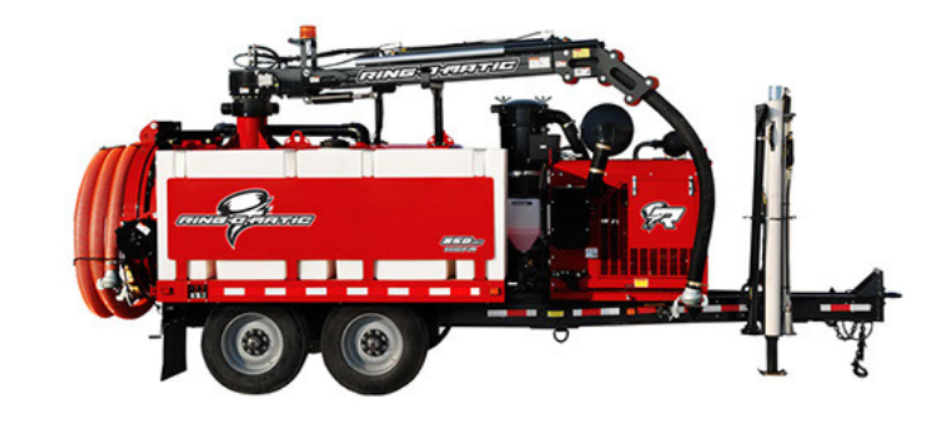In the last 15 years, vacuum excavation equipment has experienced a remarkable surge in popularity, transforming traditional excavation practices across diverse industries. Fueled by its non-destructive nature, cost-effectiveness, and environmental friendliness, this method has become a cornerstone in modern construction and infrastructure development. Let’s get into the details of vacuum excavation, examining its applications, advantages, and the innovative contributions of industry leaders like Ring-O-Matic and Haaker Underground.
Understanding Vacuum Excavation
Vacuum excavation, also known as soft excavation, is a non-destructive method that employs suction to excavate soil and materials efficiently. This technique, utilizing high-pressure water or air, revolutionizes the excavation process by offering a safer and more precise alternative to traditional digging methods.
At its core, vacuum excavation utilizes a high-powered vacuum to break up soil and debris, which is then transported through a hose into a debris tank. This method allows for precise excavation, ensuring minimal disruption to the surrounding environment. The two main types, air excavation and hydro excavation, cater to different soil types and project requirements, showcasing the adaptability of this revolutionary technique.
The versatility of our vacuum excavation trailers have led to its widespread adoption across industries. In construction, it proves invaluable for tasks like potholing, trenching, and utility location. Utility service companies utilize it for maintenance and repair of underground utility lines, minimizing the risk of damage to existing infrastructure. Environmental remediation projects also benefit from its precision and non-destructive methods.
Factors Driving Popularity
Several factors contribute to the growing popularity of vacuum excavation, making it a preferred choice in the construction and infrastructure sectors. Vacuum excavation offers enhanced safety by minimizing the risk of underground utility damage, preventing potential hazards and costly accidents. Its non-destructive nature ensures precise excavation around delicate utility lines, enhancing overall project safety. The method minimizes environmental impact by reducing soil disturbance and eliminating the need for heavy machinery. This aligns with the industry’s focus on sustainability and environmental responsibility. Vacuum excavation accelerates the excavation process, minimizing project downtime and offering substantial time and labor savings. The non-invasive nature of the technique reduces the need for extensive site restoration, ensuring overall cost-effectiveness.
Market Trends
The vacuum excavation market has witnessed substantial growth, driven by technological advancements and increasing adoption across industries. According to a report by Fortune Business Insights, the global vacuum truck market is projected to grow from $1.86 billion in 2023 to $3 billion by 2030, at a CAGR of 7.1% during the forecast period. These statistics highlight the rapid expansion and the increasing demand for vacuum excavation solutions.
Real-world examples further illustrate the growing relevance of vacuum excavation. For instance, the Vacuum Excavation Truck Market: Anticipated to Be the … report indicates that the global Vacuum Excavation Truck market was estimated at USD million as of 2022 and is anticipated to reach USD million by 2028. Additionally, companies in the construction sector have received improved demand, as indicated by PR Newswire. These instances represent a fraction of the widespread integration of vacuum excavation into diverse operational landscapes. The compelling upsurge in market size, coupled with success stories across sectors, underscores the promising trajectory of vacuum excavation.

Future Outlook and Innovations
The future of vacuum excavation technology holds exciting developments that promise to revolutionize the industry. With advancements in equipment and techniques, the potential applications of vacuum excavation are expanding and creating new opportunities across various sectors.
The latest innovations in vacuum excavation technology are enhancing efficiency, safety, and environmental sustainability. New equipment designs, such as robotic excavation systems, are streamlining the excavation process, reducing manual labor and increasing precision. These advancements not only improve productivity but also contribute to minimizing the risk of damage to underground utilities, making vacuum excavation an even more reliable and preferred method for utility and infrastructure projects.
The application of vacuum excavation is expanding beyond traditional utility and construction sectors. Emerging markets, such as renewable energy installations and urban development projects, are increasingly recognizing the value of non-destructive excavation methods.
Additionally, regions with stringent environmental regulations are adopting vacuum excavation to minimize ecological impact during excavation operations. This growth in potential applications is driving the demand for innovative vacuum excavation solutions that accommodate the specific requirements of these new sectors. Companies are actively developing specialized equipment tailored to the unique demands of emerging markets, further propelling the adoption of vacuum excavation across diverse industries.

The growing popularity of vacuum excavation underscores its role as a game-changer in modern construction and infrastructure development. With its non-destructive nature, increased efficiency, and minimal environmental impact, vacuum excavation has become the method of choice for safely uncovering utilities and excavating in congested areas. Its ability to mitigate risks, reduce project timelines, and ensure precision makes it an indispensable tool for meeting the demands of today’s construction and infrastructure projects. Embracing vacuum excavation is not just a trend; it’s a strategic decision that aligns with the priorities of safety, efficiency, and sustainability in the industry. Trust Ring-O-Matic’s line of vacuum excavation equipment through Haaker Underground in this endeavor and message us or call today at (909) 598-2706.
